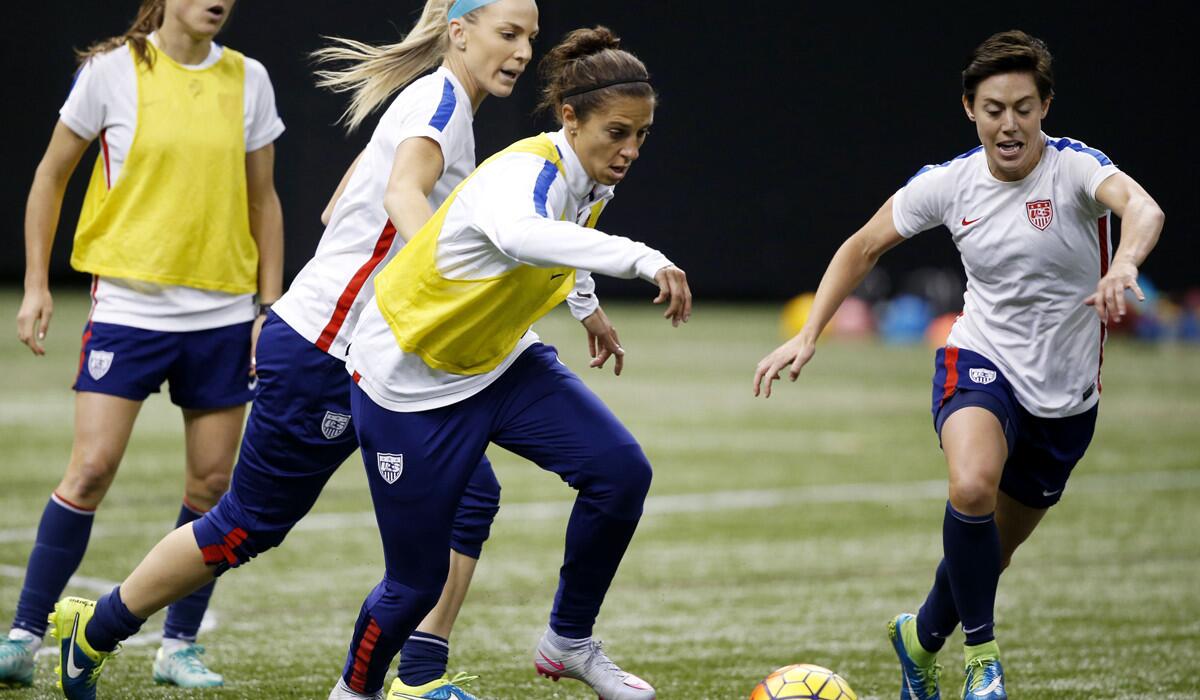U.S. women’s soccer team will rely on several players to assume Abby Wambach’s role

U.S. midfielder Carli Lloyd moves the ball past Meghan Klingenberg, right, and Julie Johnston, behind, during a practice session on Dec. 15.
- Share via
When Jill Ellis gathers her national team in Carson for the start of its winter training camp Tuesday, it will mark the first time since 2001 that the U.S. women will go into a new year unable to count on Abby Wambach.
And that leaves Ellis with a couple of big holes to fill because Wambach, who retired last month, was not only the most prolific goal-scorer, male or female, in international soccer history, she was also her team’s most forceful leader.
“What Abby did on the field, it’s very hard to replace. But the things she did off the field as well,” said defender Becky Sauerbrunn, who played seven years with Wambach. “From vocal leadership, emotional leadership and the way she was kind of an intermediary between the federation and our team and how our team should be treated.
“That will be a very difficult thing to replace.”
And Wambach’s absence will be felt beyond the U.S. team as well. In the run-up to last summer’s Women’s World Cup, Wambach helped form a coalition of five dozen top international players to file a gender-discrimination lawsuit against FIFA and the Canadian Soccer Federation over the use of artificial turf in the tournament. That the lawsuit ultimately failed isn’t as important as the fact Wambach convinced the women to stand up and be heard in the first place.
Then during the World Cup, where Wambach was a part-time player, she stood up and was heard again. When the U.S. came out of its locker room for the second half of a scoreless quarterfinal with China, Wambach gathered the players in front of their bench to deliverer a fiery — and profane — pep talk.
Six minutes later Carli Lloyd scored the game’s only goal and 10 days after that the Americans were world champions.
Sauerbrunn is confident the U.S. can fill both the voids Wambach left behind by the time it opens play in the Olympic tournament this summer in Brazil. But it will take a combination of women to do it.
“We have players that can fill kind of the emotional, vocal leadership that she was so good about,” Sauerbrunn said, naming injured midfielder Megan Rapinoe and energetic defender Meghan Klingenberg as possible replacements.
On the field she expects Alex Morgan to become the focus of the team’s offense, much as a young Wambach took over from Mia Hamm.
“Abby imparted information on to Alex and I think Alex has taken on that role really well,” Sauerbrunn said. “She’s been one of the faces of our team and she does it with poise. She’s respected and I think she’s brought more fans to the game.”
Lloyd, the hero of the World Cup, and Crystal Dunn, the leading scorer and reigning MVP of the National Women’s Soccer League, can also pick up some of the scoring slack.
But Wambach isn’t the only player the U.S. has lost since last summer.
Defender Lori Chalupny and midfielders Lauren Holiday and Shannon Boxx also retired; Rapinoe could miss most of the year after tearing her anterior cruciate ligament last month; defender Christie Rampone is recovering from arthroscopic surgery on her left knee and, at 40, may be considering retirement; and forward Amy Rodriguez is pregnant with her second child.
With Olympic qualifying beginning next month, that leaves Ellis with a lot of work to do and little time in which to do it.
The coach got a start on evaluating her new team during the three friendlies the U.S. played last month, a process she’ll continue during the 2 1/2-week training camp, which concludes with a game against Ireland on Jan. 23 at San Diego’s Qualcomm Stadium. Ellis will announce her roster for the Olympic qualifying tournament after that game.
“People always look at an event and then think about change. If you actually ask coaches, you’re constantly in that process,” said Ellis, who signed a new contract with U.S. Soccer a month after her World Cup triumph. “If you’re a coach that ever gets set, it can be detrimental.”
Making the challenge even greater, though, is the fact the top-ranked U.S. enters this year with a chance to do something no nation has ever done: win a World Cup and Olympic title in consecutive summers.
“It’s tough because there is a bit of a hangover [after] winning the World Cup. We’re celebrating but we’re also gearing up for the next thing,” said Sauerbrunn, an Olympic gold medalist in 2012 and a world champion in 2015. “It’s such a short turnaround that I can understand it’s very difficult to win back-to-back. But that’s absolutely our plan.
“We have to qualify first but [coming] away from the Olympics without a gold medal would be considered a disappointment.”
Yet for all the turnover there’s one place where the U.S. team figures to be unchanged from Canada. The back line of Sauerbrunn, Klingenberg, Julie Johnston and Ali Krieger combined to play all but nine minutes in the World Cup, helping goalkeeper Hope Solo to five consecutive shutouts. And though there has been talk of moving either Johnston or Sauerbrunn from center back to the newly depleted midfield, Ellis met privately with the players and assured them that won’t happen.
“As a back line, we really liked what we had. And we’d like to continue to grow that,” Sauerbrunn said. “What can we do next time if we work another four years [together]?”
First, however, they have to figure out a way to get beyond Wambach’s retirement.
More to Read
Go beyond the scoreboard
Get the latest on L.A.'s teams in the daily Sports Report newsletter.
You may occasionally receive promotional content from the Los Angeles Times.








